
Right this minute, in the Connecticut River, is a very large, old eel. She has a snakelike body (yet she is a fish, with fins) and is a greenish-brownish color. She is slimy and will get even slimier if she winds up on your fish hook. She has traveled far, and before her life is over, she will retrace her journey back to the middle of the Atlantic Ocean. That is, if she is not pureed in the turbines of a hydroelectric dam on her way downstream (as were up to 37 percent of the eels in a recent American study).
I must confess, I haven’t seen this particular eel myself. I’m relying on the calendar and statistics to know she is there. First, eels are active at night, and I am not. Second, I was counting on the Bellows Falls Fish Ladder to give me an underwater window to the river, but the ladder won’t be filled with water until an Atlantic salmon is spotted at the Vernon dam in southern Vermont, which hadn’t happened as of mid-June.
But the calendar and the statistics tell me she is there, somewhere. The calendar says summer, and while the water is warm, eels that are moving are moving upstream. The statistics say that nearly all of the eels that are found in Vermont and New Hampshire are female. The statistics also say that female eels may be five feet long and may live 20 years or more. The males tend to stay in estuaries, the areas where rivers and oceans meet and mix. They grow to about two feet long.
Before dams were built, American eels (there is just one species in the eastern U.S.) were found everywhere in the Connecticut River and its tributaries. A biography of George Perkins Marsh, a Vermonter sometimes called the first environmentalist, describes him catching eels in the White River when he began attending school in Royalton in 1811.
Dams reduced the number of eels in the upper Connecticut but did not eliminate them. “I’ve seen them climbing up a vertical concrete wall when they are small,” says Alex Haro, ecologist with the Silvio O. Conte Anadromous Fish Research Lab in Turners Falls, Massachusetts, and a leading eel researcher. When dams added fishways in the 1980s, and rock-climbing skills were no longer mandatory for eel survival, the number of eels in the upper Connecticut increased. “Compared to climbing over the dam, it’s easier,” Haro says of the fish ladders.
Ironically, even as we see more eels in Vermont and New Hampshire, the American eel population as a whole appears to be declining, Haro says. It’s hard to find historical records of eel populations over long periods, but the available records show eel numbers going down.
The eels swimming right now in the Connecticut River were hatched in the Sargasso Sea, the part of the Atlantic Ocean roughly between Bermuda and the Azores Islands, which is the calm center in the middle of the Atlantic held in place by swirling oceanic currents. The eels first floated around as plankton for up to a year. Then as two-inch-long, transparent “glass eels,” they found their way to Long Island Sound while their kin wound up in estuaries from Canada to South America. In Long Island Sound, they became pigmented and were then called “elvers.”
Slightly older and slightly larger “yellow eels” (actually that greenish or yellowish brown color) act like preschoolers on a playground: the girls go one way and the boys go another. While the male eels tend to stay in the estuary (like the playground, there are exceptions), the females tend to head upstream.
Haro says they will keep heading upstream every late spring, summer, and early fall for the next five to seven years. “Once they reach a certain age and size,” he says, “they settle down and set up a territory.”
Our eel will live in her territory for up to 15 more years. Then, one fall, she will turn a silver-gray color, stop eating, and start downstream. If this sounds a lot like a salmon, it is, except it is backwards. While salmon, shad and alewives are anadromous, returning to rivers to spawn, eels are catadromous, returning to the ocean to spawn.
With luck, she’ll make it back to the Sargasso Sea, where males and females from all over the western Atlantic will meet for a kind of eel spring break. After what I can only imagine as an all-too-brief orgy (brief either because it’s the only sex they will have in their lives, or because they all die when it’s over), the cycle begins again.

